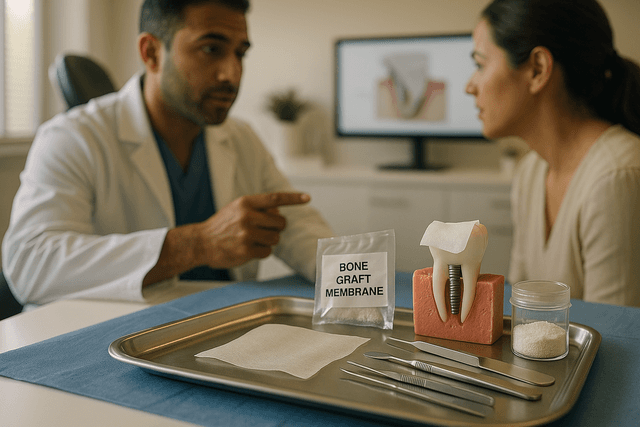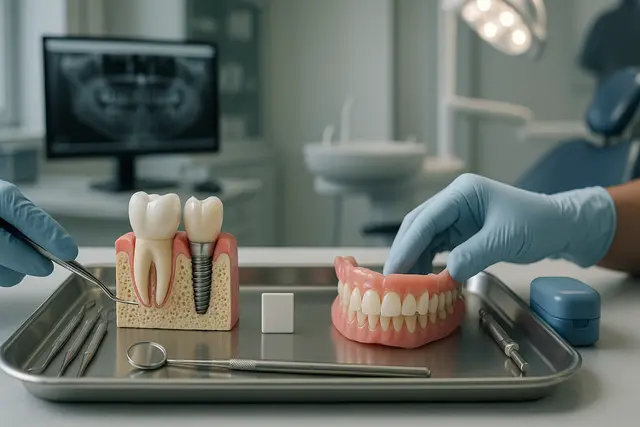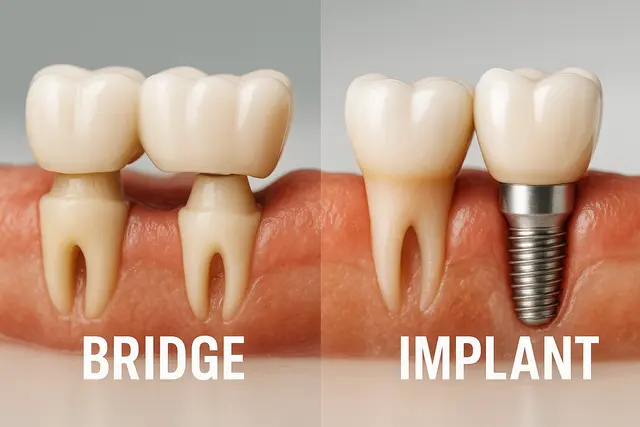Prosthodontics
5 min read
Aug 10, 2025
What Does a Bone Graft Membrane Look Like and How Is It Used?
Bone graft membranes are an essential tool in modern dentistry, helping protect and guide bone regeneration for stronger, healthier smiles. They work hand in hand with bone grafts to create a stable foundation for implants and other restorative treatments.

If you’ve ever heard your dentist mention a bone graft and membrane in the same sentence, you might have imagined something complicated and high-tech. And you wouldn’t be completely wrong. While it’s not exactly science fiction, it is one of the most important advances in modern dentistry, especially when it comes to saving smiles and supporting implants.
Understanding the Dental Graft
A graft is basically a helper. In dentistry, it’s a material placed where your body needs extra support to heal or rebuild something that’s missing. Think of it like patching a hole in a wall, but instead of drywall, it’s bone or bone-like material going into your jaw.
The graft isn’t there forever. Its job is to encourage new bone cells to move in and take over, leaving you with solid, natural bone.
What a Bone Graft Does
A bone graft is often necessary before placing a dental implant if you don’t have enough bone in your jaw. Bone loss can happen for a lot of reasons: missing teeth for years, gum disease, injury, or even natural aging.
During a bone graft procedure, your dentist or oral surgeon carefully adds graft material to the weak or missing area. Over time, your body uses this as a framework to build new bone. If all goes well, the end result is strong enough to handle an implant or keep your existing teeth stable.
What Does a Bone Graft Membrane Look Like?
If you’re picturing something bulky or complicated, you might be surprised to learn that a bone graft membrane is actually quite simple in appearance. Most membranes look like thin, flat sheets, almost like delicate tissue paper or a small piece of gauze. They’re usually white or translucent, depending on the material, and flexible enough for the dentist to shape and position over the grafted area.
Collagen membranes, which are commonly used, often have a soft, slightly sponge-like texture. They’re designed to blend naturally with your body’s healing process and eventually dissolve on their own. Non-resorbable membranes, on the other hand, are a bit sturdier and may appear more like a firm, reinforced sheet. These stay in place until the dentist removes them during a follow-up procedure.
How a Bone Graft Membrane Works
Here’s where the membrane comes in. Imagine you’ve planted grass seeds in your yard, but birds keep trying to snack on them. You’d cover them with a thin net so they can grow undisturbed. A membrane works the same way for bone grafts.
A bone graft membrane is placed over the graft to protect it and keep gum tissue from growing into the space where you want bone to form. This barrier helps guide the healing process, giving bone cells a head start and blocking out anything that might slow them down.
The Dental Bone Graft Procedure
A dental bone graft can be a small touch-up or a major rebuild. It’s done in the same appointment as a tooth extraction in some cases, or as a separate procedure if bone loss has already occurred.
Your dentist will look at the amount of bone you have and the location of the graft before deciding on the type of graft material. Some grafts come from the patient’s own bone (often considered the gold standard for bone healing), while others are synthetic grafts or made from processed donor material.
How Bone Graft Healing Happens
Bone graft healing isn’t instant. Your body needs time to create new bone cells and replace the graft. The initial healing can take a few weeks, but full bone formation can take several months.
The healing process can be influenced by your health, how much bone was added, and the type of graft procedures performed. Following your dentist’s aftercare instructions is key to promoting a successful bone regeneration.
The Different Types of Bone Grafts
There are several types of bone grafts used in dentistry:
Autograft: The patient’s own bone, often from another part of the jaw.
Allograft: Processed bone from a donor.
Xenograft: Bone from another species, usually bovine, that’s been sterilized and processed.
Synthetic Graft: Man-made materials designed to mimic bone.
Each type of graft has its pros and cons, and your dentist will choose the one that makes the most sense for your case.
The Role of Dental Implants
A dental implant is basically a tiny titanium post placed in your jaw to act like a natural tooth root. For the implant placement to be successful, there needs to be enough bone to hold it firmly. That’s why bone grafting is a surgical step that’s sometimes necessary before implant placement or dental implant surgery.
When bone grafting and implant procedures are planned together, the timing depends on your bone health and the healing required.
Choosing the Right Graft Material
The graft material can be made from different sources. Some are collagen-rich, which helps promote healing and bone growth. Others are typically made from materials designed to slowly dissolve as new bone replaces them.
Your dentist will match the type of bone graft material to your needs, whether it’s adding bone to a small defect or rebuilding significant bone before implant placement.
The Healing Process After Surgery
The healing process after a dental bone graft is all about patience. The surgical site needs time for bone formation and new bone growth. You’ll want to avoid disturbing the area, follow your dentist’s cleaning instructions, and come in for check-ups so they can confirm the graft recovery is on track.
Common Membrane Materials Used
Membrane materials vary, from collagen membrane that dissolves naturally to non resorbable membrane that must be removed later. Your dentist will choose the type of membrane based on the size of the bone defect, the type of graft, and the location of the graft.
When dentists use a membrane, it’s typically placed over the bone graft like a protective cover. This keeps the graft area safe during the initial healing stage and prevents unwanted soft tissue from interfering with bone growth.
Choosing the right type of membrane depends on factors like the patient’s health, the size of the graft, and whether implant placement will follow soon after. Some membranes dissolve on their own, while others are designed to stay in place until the dentist removes them.
Where Bone Grafts Come From
So where does the bone graft come from? It can be your own natural bone, a processed donor source, animal-derived material, or a synthetic graft. The goal is the same no matter the source: adding bone graft to restore strength and structure so your jaw can support a dental implant or other restoration.
Bone grafting is a surgical procedure, but when done by an experienced dentist, it’s one of the most effective ways to treat bone loss, fix a bone defect, and prepare for future treatments. And while it might sound a little intimidating, the success rate is high, and the benefits last for years.
What Is A Bone Graft Membrane And Why Is It Used?
A bone graft membrane is a thin barrier placed over a bone graft to protect it during healing. Its main purpose is to prevent gum tissue from growing into the graft site, giving bone cells the time and space they need to regenerate. By guiding the healing process, the membrane helps ensure that strong, healthy bone forms to support dental implants or stabilize existing teeth.
What Types Of Bone Grafts Are Available?
There are several types of bone grafts used in dentistry. Autografts use the patient’s own bone, often from another part of the jaw, and are considered the gold standard for healing. Allografts come from processed human donor bone, while xenografts are made from sterilized animal bone, usually bovine. Synthetic grafts are man-made materials designed to mimic natural bone. Each option has advantages depending on the size of the defect, patient health, and treatment goals.
How Long Does A Bone Graft Take To Heal?
Initial healing of a bone graft can take a few weeks, but complete bone regeneration often requires several months. Factors like the size of the graft, the type of material used, overall health, and adherence to aftercare instructions all affect recovery time. Dentists monitor healing through check-ups and imaging to ensure the graft is integrating properly before moving forward with procedures like dental implant placement.
Are There Different Types Of Membranes Used In Bone Grafting?
Yes, membranes can be resorbable or non-resorbable. Resorbable membranes, often made of collagen, naturally dissolve over time, eliminating the need for removal. Non-resorbable membranes, such as those made from PTFE, must be removed once healing is sufficient. The choice depends on the location of the graft, the complexity of the case, and the expected healing time. Both types are designed to protect the graft and promote predictable bone growth.
Read Next
Related Posts

Prosthodontics
Implant vs. Dentures Pros and Cons: A Deep Dive into Modern Solutions
Missing teeth can impact more than just your smile, they can affect how you eat, speak, and feel about yourself. Fortunately, modern dentistry offers two leading solutions to bring back both function and confidence: dentures and dental implants. Understanding the pros and cons of each can help you make the choice that fits your needs, lifestyle, and budget.
7 min read
Oct 17, 2025

Prosthodontics
Full Mouth Implants vs. Dentures: Which Is Better for You?
When it comes to replacing missing teeth, the choice between full mouth dental implants and dentures can be overwhelming. Each option has its own set of benefits, limitations, and long-term considerations, making it essential to understand what works best for your needs, health, and lifestyle.
5 min read
Oct 17, 2025

Prosthodontics
Tooth-Supported Bridge vs. Implant Comparison: Benefits, Drawbacks, and Insights
Deciding between a dental bridge and a dental implant can feel overwhelming, especially when both options promise to restore your smile and improve oral function. Each solution comes with its own set of benefits, considerations, and ideal use cases, making it essential to understand how they compare before choosing what’s right for you.
6 min read
Oct 17, 2025
Don’t have time to research every dentist around you?
See why 30k+ patients trusted us